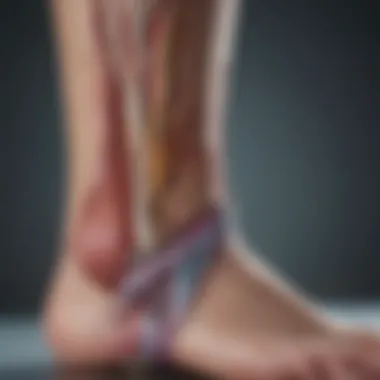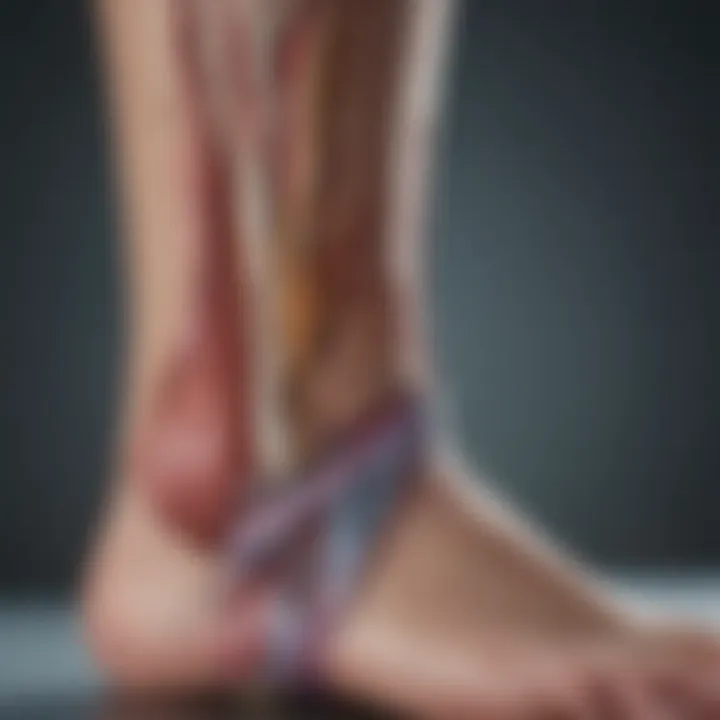Comprehensive Guide to Peroneal Vein Thrombosis Treatment


Intro
Peroneal vein thrombosis is a crucial health issue that demands immediate attention from healthcare professionals. Often overshadowed by more commonly discussed thrombotic conditions, it presents unique challenges in diagnosis and management. Understanding the factors that contribute to this condition is essential for preventing severe complications such as pulmonary embolism. The intricacies of diagnosis and treatment modalities for peroneal vein thrombosis offer insights that are both pivotal and extensive.
Key Findings
The exploration of peroneal vein thrombosis reveals several noteworthy insights that may affect treatment choices and patient outcomes.
Major Results
- Prevalence and Risk Factors: Data indicates a notable prevalence of peroneal vein thrombosis among certain populations, particularly among individuals with prolonged immobility and existing vascular complications.
- Diagnosis Methodologies: The use of ultrasound as a primary diagnostic tool has facilitated earlier detection, allowing for more timely interventions.
- Anticoagulation Therapy: Various anticoagulants, such as warfarin and newer oral anticoagulants, have shown effectiveness in reducing thrombus extension and preventing recurrence.
- Surgical Options: In severe cases, surgical interventions may be necessary. Thrombectomy can be performed to remove the clot directly, improving patient outcomes significantly.
Discussion of Findings
The findings underscore the importance of a multi-faceted approach to management. Healthcare providers must consider individual patient risk factors when diagnosing and treating peroneal vein thrombosis. The increased accessibility of diagnostic imaging methods has improved early detection rates, which is integral in reducing long-term complications. Furthermore, as more data becomes available regarding anticoagulants, the choice of treatment can be more personalized, increasing efficacy.
Methodology
Research Design
The research design focuses on both qualitative and quantitative studies, emphasizing retrospective analyses of patient records alongside prospective cohort studies. This mixed-method approach allows for a comprehensive view of treatment outcomes and effectiveness.
Data Collection Methods
Information is gathered through electronic health records, surveys from healthcare professionals, and peer-reviewed articles. This diverse collection of data ensures a robust understanding of the various aspects impacting treatment efficacy for peroneal vein thrombosis.
Effective treatment hinges on timely diagnosis and tailored patient management approaches, highlighting the necessity for ongoing education in the medical community.
By engaging with the nuances of this condition, medical professionals can stay informed on best practices, ensuring improved patient care in the long run.
Prolusion to Peroneal Vein Thrombosis
Peroneal vein thrombosis is a critical medical condition that deserves attention. Recognizing its significance helps healthcare professionals understand how it impacts patients' lives. Awareness of peroneal vein thrombosis can lead to timely intervention, which is essential in preventing severe complications such as pulmonary embolism. The discussion in this article aims to provide a comprehensive look into the various facets of this condition, including its etiology, clinical presentation, diagnosis, and treatment options.
Definition and Background
The peroneal vein is paired with the peroneal artery, located in the calf region of the leg. Thrombosis occurs when a blood clot forms within this vein, hindering normal blood flow. This condition is often linked to the presence of risk factors such as immobility, surgery, and certain medical conditions. Understanding the definition and physiological basis for peroneal vein thrombosis is the first step towards effective diagnosis and management.
Prevalence and Epidemiology
Peroneal vein thrombosis, while not as commonly discussed as deep vein thrombosis in other locations, has notable implications. Studies show varying prevalence rates depending on the underlying risk factors present. The condition is more prevalent among specific populations, such as those undergoing orthopedic surgery or individuals with cancer. Research indicates that awareness and understanding of this condition can help improve patient outcomes.
"Peroneal vein thrombosis is often overlooked, yet its implications are significant and need to be recognized by medical professionals."
In summary, the focus on peroneal vein thrombosis is necessary for advancing treatment strategies and ensuring that patients receive the appropriate care and follow-up. This section sets the stage for a detailed examination of the anatomy, etiology, diagnosis, and management strategies that will follow.
Anatomy of the Peroneal Vein
Understanding the anatomy of the peroneal vein is crucial to grasp how peroneal vein thrombosis develops and is treated. The peroneal vein plays a significant role in the venous system of the lower limb, and knowledge of its structure and function can lead to better diagnostic and therapeutic strategies.
Geographical Positioning
The peroneal vein is located in the posterior compartment of the lower leg. It typically runs alongside the peroneal artery and is situated deep within the leg muscles, particularly between the soleus and tibialis posterior muscles. Its anatomical positioning makes it less accessible than superficial veins but essential for proper blood return from the lateral and posterior aspects of the leg.
This positioning is important because it can complicate diagnosis and treatment. During imaging or surgical procedures, the concealed nature of the peroneal vein can pose challenges. Furthermore, as it connects to the tibial veins, any thrombi formation can have implications for the entire deep venous system.
Functional Role in Venous Return
The functional role of the peroneal vein is centered around venous return. It assists in transporting deoxygenated blood from the foot and lower leg back to the heart. It collects blood from smaller veins, such as those in the lateral compartment of the leg.
The presence of one-way valves helps prevent backflow, thereby promoting unidirectional blood flow. This efficiency is crucial because stagnation of blood flow can lead to conditions such as thrombosis.
Understanding these dynamics is essential in the context of peroneal vein thrombosis. An obstruction in this vein can lead to an increase in venous pressure, which can facilitate further developments of thrombus in the lower extremities. Any intervention aimed at restoring proper function must consider the vein's critical role in the venous return system.


Etiology of Peroneal Vein Thrombosis
Understanding the etiology of peroneal vein thrombosis is crucial for effective diagnosis and treatment. This knowledge helps clinicians identify patients at risk and provide prompt interventions. The etiology encompasses various risk factors and underlying biological mechanisms that lead to thrombus formation, which is essential for the overall management of the condition.
Risk Factors
Several risk factors contribute to the likelihood of developing peroneal vein thrombosis. These can broadly be classified into non-modifiable and modifiable categories:
- Non-modifiable Factors:
These include age, genetics, and certain medical conditions such as cancer or autoimmune disorders. Older age is often associated with reduced venous elasticity and increased clotting tendencies. - Modifiable Factors:
These include lifestyle choices and medical conditions that can be altered or treated. Some key modifiable risk factors are:
- Sedentary lifestyle: Prolonged immobility, such as long flights or bed rest, elevates the risk of thrombus formation.
- Obesity: Excess body weight places additional stress on the venous system, increasing the chance of thrombosis.
- Smoking: Smoking negatively affects circulation and can lead to vascular complications.
- Hormonal factors: Use of oral contraceptives or hormone replacement therapy has been linked to an increased risk of clotting.
Pathophysiology of Thrombus Formation
The formation of a thrombus in the peroneal vein involves a complex interplay of factors known as Virchow's triad: stasis of blood flow, endothelial injury, and hypercoagulability. Each of these factors contributes to the development of a clot:
- Stasis of Blood Flow:
Immobility or conditions that obstruct normal blood flow can lead to pooled blood, significantly increasing the risk of clot formation. - Endothelial Injury:
Any damage to the lining of blood vessels can provoke a thrombotic response. This can be caused by trauma, surgical procedures, or pathological conditions affecting the vascular endothelium. - Hypercoagulability:
Certain medical conditions, genetic predispositions, and medications can result in a heightened tendency for blood to coagulate. This state of hypercoagulability can lead to the formation of clots in the peroneal veins.
By addressing both the risk factors and the underlying pathophysiology, healthcare providers can more effectively manage and potentially mitigate the impact of this condition.
Clinical Presentation
Understanding the clinical presentation of peroneal vein thrombosis is critical. This condition can manifest with various symptoms. Early recognition can significantly affect management outcomes.
Symptomatology
Symptoms of peroneal vein thrombosis often present insidiously. Patients might report swelling in the affected limb. This swelling can be unilateral, affecting only one leg. Pain may occur, typically localized to the calf region. The discomfort may worsen with movement, making physical activity difficult. Additionally, there can be a feeling of heaviness or tension in that leg.
Other telltale signs include warmth and redness over the thrombosed area. In some cases, patients may experience skin changes, like discoloration. These symptoms are often not specific to this condition alone. However, their presence raises suspicion for peroneal vein thrombosis. It is important to consider these symptomatology factors when evaluating a patient’s condition. Prompt recognition leads to timely intervention.
"Early detection of symptoms is crucial for successful treatment and recovery."
Signs on Physical Examination
During a physical examination, healthcare providers should be thorough. Swelling is usually noticeable, particularly in the calf. A careful palpitation might reveal tenderness. Assessing the warmth of the skin around the affected area is also important. A temperature difference between legs can indicate an issue.
Other physical signs may include Homan's sign, although it is not reliably diagnostic. The measure involves dorsiflexing the foot to see if it elicits pain in the calf.
Healthcare professionals often utilize specific tests, such as measuring calf circumferences. A significant difference between both legs can suggest thrombosis.
Diagnosis of Peroneal Vein Thrombosis
Accurate diagnosis of peroneal vein thrombosis is crucial for effective management and treatment of the condition. Diagnosing this ailment enables healthcare practitioners to promptly implement appropriate interventions to prevent serious complications. Many patients do not exhibit noticeable symptoms, making diagnostic techniques essential in identifying affected individuals early. Without effective diagnosis, there is an increased risk of complications like pulmonary embolism, which is life-threatening. Therefore, this section elaborates on the most effective imaging techniques and diagnostic criteria necessary for confirming peroneal vein thrombosis.
Imaging Techniques
Imaging techniques are central to diagnosing peroneal vein thrombosis. They help visualize the thrombosis in its anatomical locations, enabling practitioners to assess the extent of the condition. Two primary imaging modalities commonly used are ultrasound and magnetic resonance angiography.
Ultrasound
Ultrasound is the first-line imaging technique for diagnosing peroneal vein thrombosis. It utilizes sound waves to create images of the blood vessels and can easily identify clots within the veins. A significant characteristic of ultrasound is that it is non-invasive, allowing for easy access and real-time imaging without exposure to ionizing radiation.
One of the unique features of ultrasound is its ability to provide dynamic assessment of the blood flow in the veins.
- Advantages: This capability means that clinicians can observe the blood flow in real time, allowing them to assess any occlusions or abnormal flow patterns. Furthermore, it is also cost-effective and widely available in most healthcare settings.
- Disadvantages: However, its effectiveness can be limited in patients who are obese or have extensive edema, as the quality of images may decrease in such scenarios.
Magnetic Resonance Angiography
Magnetic Resonance Angiography (MRA) is another advanced imaging technique that can visualize the peroneal veins. This method is particularly beneficial because it provides high-resolution images that detail not only the veins but also surrounding tissues. The key characteristic of MRA is its use of magnetic fields and radio waves, which offers excellent soft tissue contrast.
The unique aspect of MRA is that it can detect smaller thrombi that ultrasound might miss, aiding in accurate diagnosis.
- Advantages: MRA is advantageous because it is a non-invasive method with no exposure to ionizing radiation, making it safer for patients requiring multiple imaging studies.
- Disadvantages: It is, however, more expensive than ultrasound and not as readily available, requiring specialized equipment and expertise to interpret the results.


Diagnostic Criteria
Effective diagnosis of peroneal vein thrombosis relies on a combination of clinical assessment and imaging findings. Recognizing the signs and symptoms early can lead to timely interventions. Key diagnostic criteria include:
- Clinical history of risk factors such as prolonged immobilization or surgery.
- Physical examination findings suggesting venous thrombosis.
- Positive findings from imaging techniques, particularly ultrasound or MRA, confirming the presence of a thrombus in the peroneal vein.
In summary, establishing an accurate diagnosis of peroneal vein thrombosis is vital for patient outcomes. Utilizing appropriate imaging techniques alongside clinical evaluations captivates a comprehensive approach to diagnosis.
Management Strategies
Management strategies for peroneal vein thrombosis (PVT) are essential in preventing complications and facilitating recovery. Prompt and appropriate treatment not only addresses the immediate issues related to thrombus formation but also helps reduce the risk of post-thrombotic syndrome. The management of PVT typically involves both pharmacological and surgical approaches, depending on the severity and particular characteristics of the condition.
Anticoagulation Therapy
Anticoagulation therapy serves as the cornerstone of PVT management. This approach helps dissolve blood clots and prevents further thrombus formation, which is critical in reducing potential complications associated with PVT.
Types of Anticoagulants
There are several types of anticoagulants used in the treatment of PVT. The main categories include:
- Direct oral anticoagulants (DOACs): These have gained popularity due to their convenience and predictable pharmacokinetics. Medications such as apixaban and rivaroxaban fall under this category. They do not require regular monitoring, which enhances patient adherence.
- Warfarin: Though its use has declined in recent years, it can still be effective. It requires periodic blood tests to monitor INR levels, making it less convenient than DOACs.
- Heparin: This is often used in acute settings, particularly low molecular weight heparin (LMWH). LMWH is particularly beneficial due to its ability to be administered subcutaneously, allowing for outpatient treatment.
Each type has its key characteristics. DOACs are often preferred for their ease of use, while Warfarin remains critical for certain patients, especially those with specific risk factors or renal considerations.
Dosing Considerations
Dosing is crucial in anticoagulation therapy and varies between the different drug classes. For example:
- DOACs: Dosage is typically fixed based on the patient's renal function and body weight. Maintaining the appropriate dose is essential for minimizing the risk of bleeding.
- Warfarin: This requires individualization based on INR results and the patient’s overall health condition. Patients may need adjustment of doses based on diet and interactions with other medications.
- Heparin: For inpatient settings, weight-based dosing may be used and adjusted according to aPTT values, ensuring effective anticoagulation.
Incorrect dosing can lead to serious complications, including bleeding or recurrent thrombosis, so careful monitoring is vital.
Surgical Interventions
While anticoagulation is the first-line treatment for PVT, surgical interventions may be necessary for certain cases where thrombus persists or responds poorly to medical management.
Thrombectomy Procedures
Thrombectomy procedures involve the physical removal of the clot. This can be done through a minimally invasive surgical approach or traditional open surgery. The advantages of thrombectomy include:
- Quick resolution of symptoms, improving blood flow promptly.
- Reduced risk of long-term complications, such as post-thrombotic syndrome.
However, this type of procedure carries risks. Surgical complications such as bleeding or infection can occur, and not all patients may be suitable candidates for surgery based on their overall health and thrombus characteristics.
Advanced Minimally Invasive Techniques
Emerging surgical approaches like catheter-directed thrombolysis offer less invasive options for managing PVT. These techniques involve:
- Direct delivery of thrombolytic agents to the site of the thrombus, allowing for targeted treatment.
- Shortened recovery times compared to traditional surgical methods.
Such advanced techniques can minimize trauma to the surrounding tissue, but they may involve risks such as catheter-related complications and bleeding, necessitating experienced surgical teams for optimal outcomes.
Monitoring and Follow-Up
Monitoring and follow-up are critical components in the management of peroneal vein thrombosis. Timely and effective monitoring can significantly influence patient outcomes by ensuring treatment efficacy and reducing risks of complications. Establishing a robust follow-up strategy allows for ongoing assessment and adjustment of therapeutic interventions, based on individual patient response. In this context, both monitoring and follow-up can facilitate better overall healthcare delivery.
Importance of Monitoring
Monitoring in peroneal vein thrombosis primarily involves the assessment of treatment effects and patient status. This process can identify whether anticoagulation therapy is functioning as intended.
Overseeing Anticoagulation Effectiveness
Effectively overseeing anticoagulation is paramount. It is essential because appropriate anticoagulation reduces the risk of thrombus extension and complications such as pulmonary embolism. The key characteristic of this monitoring is the adjustment of anticoagulant dosages based on regular blood tests, notably INR (International Normalized Ratio) for Vitamin K antagonists. This approach allows clinicians to achieve and maintain therapeutic levels, minimizing risks associated with under or over-anticoagulation.


The unique feature of overseeing anticoagulation effectiveness lies in its ability to offer real-time data on patients' coagulation status. This is beneficial as adjusting medications can prevent adverse outcomes. However, there may be disadvantages, such as complexity in monitoring protocols and the potential for patient's adherence issues.
Detecting Complications
Detecting complications is another vital aspect of patient monitoring. The capacity to discover issues early can mitigate serious consequences. The key characteristic of this process is focused surveillance of symptoms and health changes indicative of complications, such as increased pain, swelling, or signs of venous insufficiency.
The unique feature of detecting complications involves vigilant clinical evaluation and awareness of patient-specific risks. Early detection strategies can prevent major health events and facilitate timely interventions. The challenge remains in the standardization of detection methods, which could vary per clinical setting.
Guidelines for Follow-Up Care
Follow-up care requires systematic guidelines to ensure that patients receive continuous and appropriate attention after initial treatment. These guidelines often include periodic reevaluation of the patient's condition and treatment response.
The frequency of follow-up visits may vary based on patient risk factors and treatment specifics. Generally, patients should be observed within one to three months after treatment initiation, and adjustments made as necessary. Guidelines may emphasize:
- Regular clinical assessments to monitor for potential recurrence.
- Updated imaging studies if symptoms persist or worsen.
- Education on signs and symptoms of complications that warrant immediate care.
In summary, monitoring and follow-up are essential for managing peroneal vein thrombosis effectively. They foster a proactive approach that not only improves the efficacy of treatments but also enhances patient safety and overall healthcare quality.
Emerging Trends in Treatment
Novel Anticoagulants
Recent advancements in pharmacology have introduced novel anticoagulants that offer specific benefits over traditional options. Medications such as rivaroxaban and apixaban are gaining attention because they provide predictable anticoagulation effects without the need for frequent monitoring. Their oral administration also adds convenience for patients, promoting adherence to treatment plans.
Notably, these medications target specific pathways in the coagulation cascade, lowering the risk of thrombus formation in a more efficient manner. It is essential to weigh the benefits against potential drawbacks. Some novel anticoagulants come with a different bleeding risk profile, which requires careful patient selection and monitoring. However, their role in treating peroneal vein thrombosis is an area of ongoing research, with promising results prompting further exploration in clinical settings.
Gene Therapy Approaches
Gene therapy is another innovative direction in the treatment of peroneal vein thrombosis. This approach aims to address the underlying genetic predispositions that contribute to thrombus formation. By modifying or correcting the genetic factors involved in clotting, healthcare providers can potentially reduce the risk of thrombosis effectively.
For instance, introducing genes that promote natural anticoagulants could change the landscape of how thrombosis is managed. Current studies are investigating the methods to deliver these gene modifications safely and effectively, such as using viral vectors or nanoparticles. While still in experimental stages, the potential of gene therapy to minimize recurrence of thrombosis stands out as a significant advancement in vascular medicine.
As these treatments continue to evolve, healthcare professionals must stay informed about the latest research to make informed decisions for their patients.
Complications and Prognosis
Understanding the complications and prognosis related to peroneal vein thrombosis is crucial for both patient management and preventive strategies. This aspect of treatment encapsulates the potential risks that may arise if the condition remains untreated, as well as the expected outcomes following appropriate intervention. Properly addressing these issues not only enhances clinical decision-making but also informs patients and caregivers about what to anticipate, thus improving their quality of life.
Potential Complications
Peroneal vein thrombosis can lead to a range of complications that may significantly affect patient health. Some of the most common complications include:
- Pulmonary Embolism: This is perhaps the most serious complication and occurs when a thrombus dislodges and travels to the lungs, potentially causing obstruction in the pulmonary arteries. Symptoms may include sudden shortness of breath and chest pain.
- Post-Thrombotic Syndrome: Patients might experience persistent pain and swelling in the affected limb, as well as skin changes. This is due to chronic changes in the venous system resulting from the original thrombosis.
- Venous Ulcers: Damage to the venous circulation can lead to poor healing and the formation of ulcers, which can become chronic and difficult to treat.
- Recurrent Thrombosis: There is also a risk of developing new clots, particularly if underlying risk factors such as immobilization remain unaddressed.
"The key to managing peroneal vein thrombosis lies in prompt recognition and effective treatment to mitigate risks of complications."
Awareness of these complications can guide both clinicians and patients in monitoring symptoms and seeking timely intervention, thereby reducing overall morbidity associated with the condition.
Long-Term Outcomes
The long-term outcomes for patients with peroneal vein thrombosis depend on several factors, including the promptness of diagnosis, the effectiveness of treatment, and the patient's overall health. Generally, the prognosis can be affected by the following elements:
- Quality of Management: Proper anticoagulation management reduces the likelihood of complications and can significantly improve long-term outcomes.
- Lifestyle Modifications: Patients who adhere to lifestyle changes, such as increased physical activity and smoking cessation, often report better outcomes. These modifications contribute to improved venous health over time.
- Monitoring for Recurrence: Regular follow-ups are essential to assess for new thrombotic events. Continued medical supervision enhances the prognosis, allowing for timely adjustments in treatment for those at risk.
- Comorbid Conditions: The presence of other health issues, like obesity or cardiovascular disease, can compromise recovery. Managing these comorbidities is vital in improving the prognosis.
Studies suggest that with proper intervention and management, many patients can lead normal lives post-thrombosis. However, some may continue to experience chronic issues, underscoring the necessity for ongoing care and personalized treatment plans.
The End and Future Directions
Summary of Key Findings
This article has outlined several fundamental aspects regarding the treatment of peroneal vein thrombosis. It encompasses a thorough examination of the condition's etiology, diagnostic techniques, and management strategies.
- Etiology: Recognition of risk factors is essential. Genetic predispositions, lifestyle choices, and comorbidities influence thrombus formation.
- Diagnosis: Advanced imaging methods, such as ultrasound and magnetic resonance angiography, are valuable for accurate identification of the condition.
- Management: Anticoagulation therapy remains the first line of treatment, incorporating various anticoagulants and individualized dosing strategies. Surgical approaches, such as thrombectomy, also play a pivotal role, especially in acute scenarios.
- Emerging Trends: Understanding novel anticoagulants and gene therapy presents an exciting frontier for treatment options in the years ahead.
These findings underscore the importance of early intervention, along with tailored management protocols, to mitigate the risk of serious complications. Overall, comprehensive knowledge and proactive approaches are fundamental in guiding clinicians and researchers alike.
Research Gaps and Opportunities
- Limited Longitudinal Studies: There is a scarcity of long-term studies that illustrate the effects of various treatment modalities over extended periods. Addressing this can provide clearer insights into outcomes and complications.
- Personalized Medicine: Further research on genetic profiling may lead to more personalized therapies. Understanding individual responses to anticoagulants could enhance safety and efficacy.
- Integration of Technology: Exploring the use of telemedicine and digital health solutions can improve monitoring and follow-up care.
- Education and Awareness: Increasing clinician awareness and patient education surrounding the condition can lead to more timely diagnoses and improved care outcomes.
Thus, future directions in research must focus on addressing these gaps to enrich knowledge and enhance treatment pathways. By focusing on these areas, the field can strive for better management, fostering a proactive approach to patients suffering from peroneal vein thrombosis.



